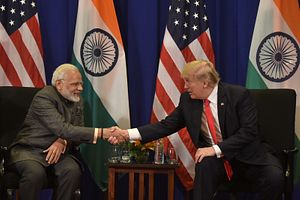After two rounds of scheduling delays, the United States and India are scheduled to hold their first-ever so-called ‘two-plus-two’ meeting in New Delhi next Thursday. The encounter will bring together U.S. Secretary of Defense Jim Mattis, U.S. Secretary of State Mike Pompeo, Indian Minister of External Affairs Sushma Swaraj, and Indian Minister of Defense Nirmala Sitharaman. Both countries will confer on bilateral, regional, and global issues, including the state of the U.S.-India defense relationship.
Speaking on Wednesday at the Carnegie Endowment of International Peace, Randall Schriver, the assistant secretary of defense for Asian and Pacific security affairs at the U.S. Department of Defense, offered a preview of the agenda next week from the United States’ perspective. “We have an opportunity to advance the relationship in significant ways,” Schriver noted. “We’ll talk about regional issues and strategic issues.”
“China and how to respond to that will be front and center,” Schriver said. “Other aspects of promoting the free and open Indo-Pacific; how we approach Southeast Asia; I think we’ll talk about Afghanistan, our shared interests there in driving that to a political settlement,” he continued. On bilateral issues, Schriver acknowledged that the United States and India were still working on foundational—or “enabling” agreements—for closer bilateral military coordination.
The two outstanding agreements are COMCASA, or the Communications Compatibility and Security Agreement, and BECA, the Basic Exchange and Cooperation Agreement for Geo-spatial Cooperation. Negotiations on the former are close to their conclusion, with a few remaining reservations on the Indian side concerning sovereignty.
BECA talks had not started as of late-July, but will begin soon. In 2016, the United States and India concluded the first of the enabling agreements after more than a decade of talks; the Logistics Exchange Memorandum of Agreement (LEMOA). LEMOA allows the armed forces of both sides to mutually access logistical support for compensation either in kind of cash.
“I think we’re going to expand the scope of some of our exercises,” Schriver added. The United States and India conduct a range of exercises, but are expected to conduct a first-ever three-service exercise later this year. The upcoming meeting may also address the addition of more specialized exercises beyond the main Yudh Abhyas and Malabar exercises.
The upcoming two-plus-two meeting will emphasize the continuity in the U.S.-India relationship from the Obama administration into the Trump administration—at least on matters of defense and strategic cooperation. Last year, during Indian Prime Minister Narendra Modi’s trip to Washington, D.C., he and U.S. President Donald J. Trump pledged to position their countries as “responsible stewards in the Indo-Pacific region.”
In the lead-up to the upcoming meeting, the U.S. Department of Commerce designated India a Strategic Trade Authorization Tier 1 country, granting New Delhi access to a wider range of U.S. defense products. That too builds on the 2016 designation of India as a U.S. Major Defense Partner, which sought to give New Delhi access to U.S. defense technology at a level comparable to a NATO ally.

































